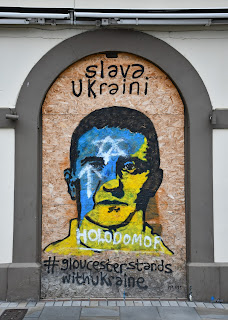Gloucester and Cheltenham
As the last week of school drew to a close, I let myself go. I had submitted my applications and finished my classes, so now was the time to have fun and catch up with friends. Not that I hadn’t seen them at all during term time, but certainly not as much as I would have liked to. On Friday, a few of us visited a Slovak restaurant in Cowley, and at a subsequent get-together at Saint Cross, I made plans with my friend Johnny to make a trip the following day.
We departed
for Gloucester on Saturday morning, changing trains at Didcot Parkway. Johnny’s
foresight guaranteed us an exciting journey: we watched Crouching Tiger, Hidden
Dragon on his iPad, though I am not sure what was more action-packed – the film
itself or my frantic scanning of the Chinese subtitles. At Didcot, we got so
engrossed that we almost missed our connection.
Gloucester’s major attraction is its cathedral, an establishment that dates to the seventh century but whose modern contours were definitively drawn in the fifteenth century. The building has several claims to fame. Firstly, it houses the tomb of Edward II, a king who was famously defeated by Robert the Bruce of Scotland and overthrown by his own wife and her lover. Secondly, its cloisters are the earliest surviving example of fan vaults, which proliferated around England after their doubtlessly smashing success in 1351. Finally, its Great East Window was once the largest in the world and remains to this day the largest in England, a place where it is admittedly much easier to retain such a primacy.
The rest of
Gloucester is a little less spectacular, as ruins and defunct industries make
up the city’s remaining attractions. These include Saint Oswald’s Priory, the
Infirmary Arches by the cathedral, and Greyfriars; only the Blackfriars Priory
has escaped this dreadful fate. We were surprised to find that the city’s docks
were quite extensive, as one would have had to travel quite a distance along
the winding Severn to reach the sea – that is, at least until the construction
of the Gloucester and Sharpness Canal in the 19th century.
We ate
lunch at the docks and set off for Cheltenham, our next destination. Although
we reached the town well in advance of two o’clock, the bus scheduled for that
time never materialised. I struggle to come up with an explanation for its
almost magical disappearance off the face of the earth, especially as the bus
scheduled for 14:20 arrived almost precisely on time (and, in fact, left one
minute early). Perhaps we will never know. In any case, we rode it until the
Pittville Pump Room, from whence we continued south into the city itself.
Cheltenham
is a truly strange place. For one, it no longer seems to serve as a spa town,
seeing as the buildings clearly meant for that purpose have been put to other
uses. Most of its attractions, particularly the churches, were closed when we
visited, and the synagogue lay hidden surprisingly far away from where Google
Maps said it would be. Furthermore, when we arrived at the Neptune Fountain, we
found it flanked by an immobile crane, as though nothing could accompany
neo-classical beauty than unfinished construction work. Perhaps most
opprobrious, however, is the town’s fawning obsession with Gustav Holst, whose
works could only have achieved prominence in a musical wasteland like the
British Isles.

































Comments
Post a Comment